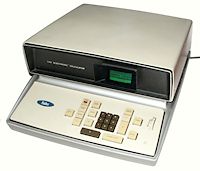 Friden Model 132, S/N 2811A
Friden Model 132, S/N 2811A
Functions: ASMD, square root, 1 memory
Technology: Discrete-component, delay line memory
Display: 13 digits, 4 registers, CRT display
Dimensions: 470W x 560D x 250H, weight 19.5kg
Manufactured: Friden, USA, 1966
This page shows a selection of early desktop calculators from a variety of manufacturers. Please refer to the separate brands listings for early electronic calculators from Canon, Casio, Sharp, and others.
Click on the photos for larger illustrations, or follow the links for further details.
 Friden Model 132, S/N 2811A
Friden Model 132, S/N 2811A
Functions: ASMD, square root, 1 memory
Technology: Discrete-component, delay line memory
Display: 13 digits, 4 registers, CRT display
Dimensions: 470W x 560D x 250H, weight 19.5kg
Manufactured: Friden, USA, 1966
The Friden EC-130 from 1964 was one of the very first all-transistor electronic calculators. The circuitry was built entirely with discrete components, with internal storage provided by a mechanical delay line memory. The calculator used "reverse Polish" notation, with the four stack registers visible simultaneously on a cathode ray tube display.
This EC-132 from 1965 was basically identical to the EC-130, but with the addition of a square root function.
The machine illustrated was purchased in 1966 by the Australian Mineral Development Laboratories, at a price in the thousands of dollars. It was obsolete and sold for scrap within three years.
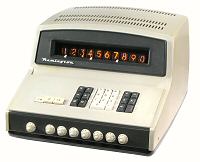 Casio Model 101, S/N B-3595
Casio Model 101, S/N B-3595
Functions: ASMD, constant, 1 memory
Technology: discrete-component DTL
Display: 10 digits, Nixie tube
Dimensions: 380W x 450D x 260H
Weight: 13.9kg
Manufactured: Casio Computer Co, Japan, 1966. (Sold by
Remington)
Casio's first electronic calculator (the Model 001) was released in September 1965, and was updated the following year to become the Model 101. Casio's first export shipment was made in September 1966, when a consignment of Model 101 calculators was sent to Australia. The machines carried a small "Remington" badge and were sold through the long-established Remington dealerships. The Casio 101 was priced at $1670, which was about 50% more expensive than a top-of-the-line fully-automatic mechanical calculator.
The Casio 101 is a very capable machine, considering the state of development at the time. The display is normally right-aligned with leading zeros, and has a backspace key to correct errors. A six-digit constant factor with a decimal point can be set on the seven front-panel dials and accessed with the K key. The leftmost dial sets the display for 0 to 9 decimal places. The single memory register can be accessed directly with the M and F keys, or it can be set for automatic accumulation of products with the Σ (sigma) key. A red = (equals) key subtracts the product, or displays the complement of the last result. The FA key left-aligns the display for division and for double-precision multiplication. The machine will multiply two 10-digit numbers to produce a 20-digit result, with the least significant digits returned in the memory register.
The
internal view shows a heavy sheet-metal card cage containing 9
logic boards, each measuring 310 x 180mm. The boards are said to
contain over 10,000 discrete components. The display board with 10
NEC Nixie-style tubes is mounted at the front of the card cage. The
keyboard frame is a heavy metal die-casting, with the power supply
mounted underneath. The moulded plastic casing (about 6mm thick)
has a removable panel in the base to give access to the hand-wired
backplane.
Internal view (30kb)
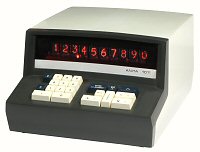 Anita 1000 Series, Model 1011, S/N M2971
Anita 1000 Series, Model 1011, S/N M2971
Functions: ASMD, constant, percent, 1 memory
Technology: Discrete-component DTL, 7 IC chips
Display: 10 digits, Nixie tubes
Dimensions: 265W x 335D x 175H
Weight: 5.9kg
Manufactured: Bell Punch Company, England, January 1970
The Bell Punch Company of England is generally credited with building the first production electronic calculator - the ANITA - in 1962. This 10-key Anita Model 1011 was made in England in early 1970, using discrete-component diode and transistor logic and a small number of MOS integrated circuits. More...
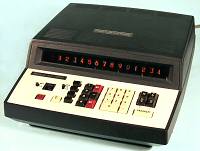 Casio Model AL-2000, S/N 205664
Casio Model AL-2000, S/N 205664
Functions: ASMD, square root, 4 memories
Programming: 30 steps, 14 instructions, no conditionals
Technology: DTL (MSI and discrete), magnetic core memory
Display: 14 digits, miniature Nixie tube
Dimensions: 340W x 400D x 150H
Weight: 6.8kg
Manufactured: Casio, Japan, 1970. (Sold by Remington)
The AL-2000 is a very early programmable desk calculator, introduced by the Casio Computer Co Ltd of Tokyo, Japan, in November 1969. The machine uses a mixture of discrete-component and integrated-circuit diode-transistor logic, and contains two special MSI (medium-scale integration) MOS chips. A magnetic core memory module from Mitsubishi provides 512 bits of memory (yes, bits) for the working registers and the program. More...
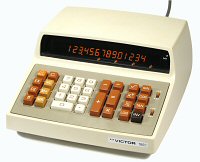 Victor 1800 Series, Model 18-1721, S/N 4676-666
Victor 1800 Series, Model 18-1721, S/N 4676-666
Functions: ASMD, trig, log, powers, 1 memory
Technology: MOS-LSI (Rockwell, 6 chips)
Display: 14 digits, 7-segment neon (Panaplex)
Dimensions: 250W x 290D x 130H
Weight: 2.78kg
Manufactured: Victor Comptometer Corp, Chicago, 1973
The Victor Comptometer Corporation sold a range of attractive and functional desktop calculators under the "Victor 1800" label from around 1971.
The machine illustrated is a "scientific" model that was built in mid-1973. It provides trig and log functions and their inverses, powers, square roots, and reciprocals. It operates in degrees or radians, and in common or natural logarithms. There is a single (accumulating) memory register. More...
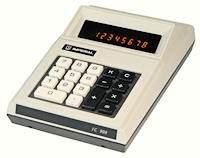 Imperial (Litton) Model IC-900, S/N 8D-48453
Imperial (Litton) Model IC-900, S/N 8D-48453
Functions: ASMD, K
Technology: MOS-LSI, single chip (GI G-500)
Display: 8 digits, gas discharge module
Dimensions: 140W x 225D x 65H
Weight: 0.83kg
Manufactured: Made in Japan for Royal Imperial International
Frankfurt, 1973.
The Imperial IC-900 is a basic 4-function calculator that was made in Japan for Litton Industries in 1973. Litton started as a small electronics company in the 1950s, and eventually became a major supplier of military equipment. Along the way they acquired the famous "Royal" typewriter brand, which was used for a time on some mechanical and electronic calculators. Litton also owned the American Monroe brand (from 1958) and the European Triumph-Adler (from 1968).
The Imperial IC-900 uses a General Instruments G-500 processor in a 24-pin DIL ceramic pack, assisted by 28 discrete transistors. The "Panaplex"-style gas discharge display is a "Flandipak" module made by Matsushita Electric. The CPU, display, and keyboard are all dated April or May of 1973.
The calculator operates in algebraic mode, with a decimal point floating within the 8-digit range. Overflow shows the 8 most significant digits without a decimal point, but does not lock the machine. Division by zero lights all decimal points, but leaves two of the digits counting continuously until cleared. The "Constant" function is different to most later machines. After the constant (eg 2) is entered with the sequence 2 = K, it is only necesary to enter the next number and touch the function key to display the result. For example, 3 Mult shows 6, 5 Div shows 2.5, etc. Incorrect key sequences can produce large and irrelevant results.
Internal view (31kb)
Circuit board detail (44kb)
 "TE8000", S/N 55105622
"TE8000", S/N 55105622
Functions: ASMD, K
Technology: MOS-LSI, single chip (TI TMS-0105)
Display: 8 digits, Futaba VFD tubes DG10R1
Dimensions: 140W x 210D x 80H
Weight: 0.76kg
Manufactured: Unknown, 1973.
Texas Instruments built the first of their single-chip MOS-LSI calculator processors (the TMS-0100 series) in 1971. As these devices became commercially available and prices rapidly fell, it became possible for just about anyone to build an electronic calculator. This TE8000 is a "no-name" four-function machine using a TMS-0105 single-chip processor from 1973. More...